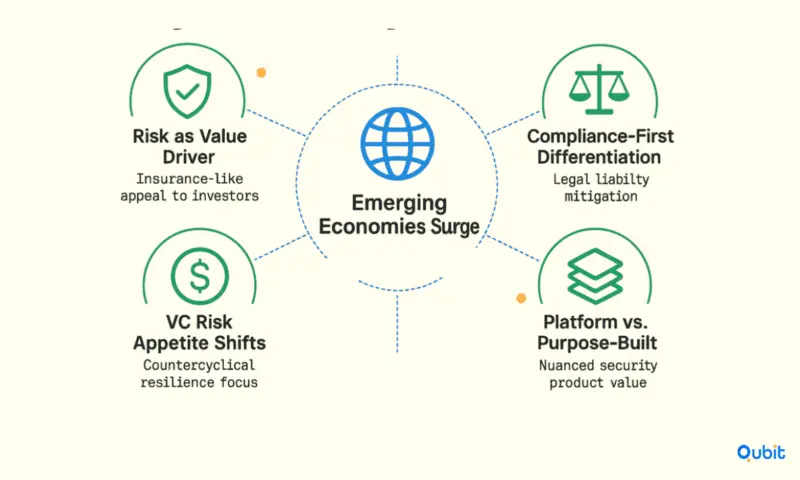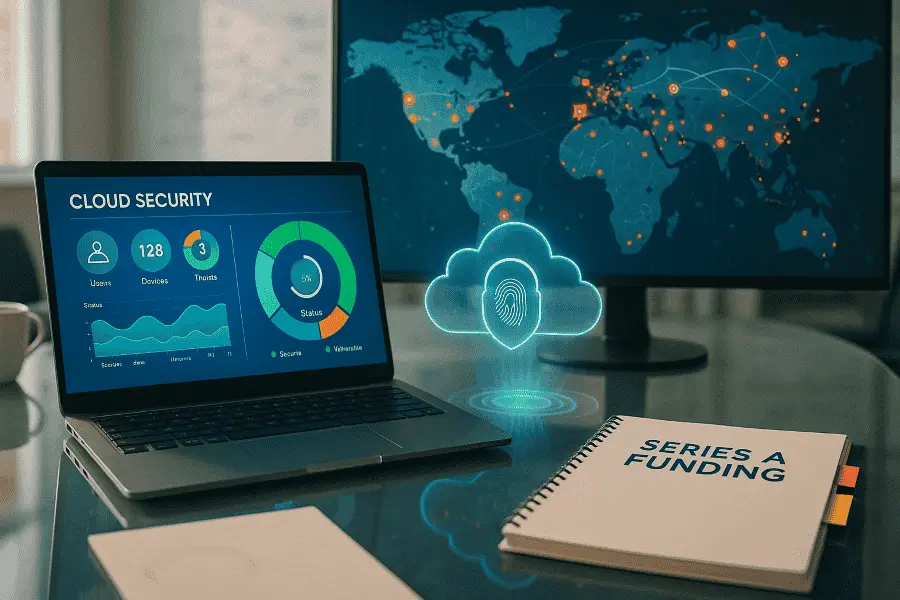The global cybersecurity market is on a remarkable growth trajectory, projected to reach USD 500.70 billion by 2030, with a compound annual growth rate (CAGR) of 12.9% starting in 2025. This surge underscores the increasing demand for innovative cybersecurity solutions.
It creates a fertile ground for startups aiming to secure funding. For emerging ventures, understanding how to align their offerings with market needs is critical to attracting investors.
This blog will guide cybersecurity startups on securing funding by focusing on board-level metrics and strategies in areas like cloud security, identity and access management (IAM), threat intelligence, and IoT security. Let’s jump right in.
The Growing Importance of Cybersecurity in Boardroom Discussions
Recent capital trends reinforce this shift. In Q4 2024, cybersecurity funding rose by 7% to $1.7 billion compared to Q4 2023. This surge underscores boardroom urgency and the confidence investors place in robust security innovations.
As cybersecurity becomes a staple in boardroom conversations, executives are increasingly aware of its role in shaping a startup’s trajectory. Investors and board members are no longer content with vague assurances about security measures. Instead, they demand clear, data-driven insights into how cybersecurity strategies align with business goals. This shift reflects a broader trend of boards and executives taking a more active role in understanding and addressing cybersecurity risks.
For startup CTOs, this means preparing to answer critical questions:
– What security standards are necessary to meet industry and investor expectations?
– How can cybersecurity risks be effectively communicated in business terms?
– What metrics demonstrate the return on investment (ROI) for cybersecurity initiatives?
Your evaluation of monetary benchmarks is enhanced by an overview of SASE and Zero-Trust investment metrics that outlines the performance indicators favored by investors.
Market Differentiator and Macroeconomic Drivers
Digital security has shifted from a cost center to a value driver. This change reflects tighter privacy policies and widespread adoption of cloud strategies.

The shift is particularly noticeable in emerging economies, where digital transformation is accelerating. From small enterprises adopting remote work infrastructure to multinationals investing in data sovereignty, the DNA of cybersecurity investment is diversifying. More than ever, investors are differentiating between generic protection platforms and nuanced security products purpose-built for compliance, enabling them to mitigate legal liability while opening new markets.
Macroeconomic instability, geopolitical tensions, and rising digital attacks on critical infrastructure have further reshaped how VCs and private equity firms view risk. Cybersecurity startups now occupy a favored status for countercyclical resilience, providing “insurance-like” value even during market contractions.
For instance, your reflection on early-stage investment approaches is complemented by insights into seed funding for passwordless authentication startups, which detail the financial strategies emerging within the authentication space. Startups that prioritize security early on not only protect their assets but also position themselves as trustworthy partners for customers and investors alike.
Evolving Threat Landscape
Threat actors are operating with unprecedented scale and sophistication. What used to be opportunistic attacks have evolved into persistent, state-sponsored threats and complex criminal enterprises. The rapid digitalization of supply chains, smart devices, and edge computing has led to new exploitable surfaces.
From ransomware-as-a-service (RaaS) platforms to deepfake-enabled phishing and synthetic identity fraud, threat vectors are expanding in both complexity and frequency. This rise has created space for startups focusing on threat modeling automation, behavioral analytics, and cyber deception.
Moreover, the threat landscape is not uniform, it differs by region and industry. In critical sectors like healthcare and education, where legacy infrastructure is common, attackers exploit operational weaknesses. Conversely, in BFSI or fintech environments, AI-driven attacks target transactional systems and APIs.
Startups capable of industry-specific threat recognition and proactive mitigation protocols are seeing higher valuation premiums during funding rounds.
Communicating Cybersecurity ROI to Investors
One of the most significant hurdles for CTOs is translating technical cybersecurity measures into business value. Investors want to see how security investments contribute to the bottom line, whether through cost savings, risk reduction, or enhanced market competitiveness.
To bridge this gap, CTOs must adopt a proactive approach to risk management and security assessments. By quantifying potential losses from data breaches and demonstrating how security measures mitigate these risks, startups can present cybersecurity as a cost-effective investment.
Your analysis of investment trends is further enriched by the considerations outlined in investor demand for AI-driven threat intelligence platforms, which align technological advancements with market interest. Highlighting the financial and reputational benefits of advanced security solutions can make a compelling case for investors.
Key Takeaways for Board-Level Cybersecurity Discussions
- Cybersecurity is a strategic business imperative: It builds market trust and enhances investor confidence.
- Proactive risk management is essential: Clear assessments and actionable insights are critical for board-level discussions.
- Articulating ROI is a priority: CTOs must translate technical measures into business value to secure funding.
By addressing these areas, startup CTOs can turn cybersecurity from a challenge into an opportunity, positioning their companies for long-term success.
Your Strategic Insights for the Boardroom
Cybersecurity startups can secure funding by aligning technical innovation with investor and market needs, choosing diverse financing options, and presenting clear ROI and board-level metrics.
- Assess market fit
- Identify funding options
- Prepare ROI metrics
- Develop investor pitch
- Diversify funding sources
Example: A startup with a SaaS model can pursue VC and angel funding, while a hardware-focused firm may access R&D grants.
Startup CTOs often find themselves at the intersection of technology and business strategy, particularly when it comes to securing funding. Among the many challenges they face, articulating the value of cybersecurity investments to investors is one of the most pressing. Cybersecurity startup funding has evolved beyond a technical concern; it is now a strategic business imperative that influences market trust and investor confid
Innovations in Cybersecurity
Innovation in cybersecurity has moved well beyond firewalls and antivirus tools. Today, emerging categories are capturing investor attention:
What separates these frontier technologies is not just technical novelty—it’s market timing and vertical integration. For example, confidential computing’s relevance has soared due to stringent cloud governance laws in European markets. Similarly, passwordless authentication appeals to SaaS platforms prioritizing UX while needing to meet identity verification standards.
Emerging Business Models in Cybersecurity
Explore innovative monetization methods gaining traction in the industry:
- Cybersecurity-as-a-Service (CSaaS): Subscription-based, pay-as-you-go security services for SMEs and mid-market buyers.
- Bug Bounty Platforms and Crowdsourced Security: Analysis of how platforms like HackerOne and Bugcrowd drive continuous testing and foster trust.
- Data-Driven Security Insurance: Startups partnering with insurers to offer cyber risk policies bundled with proactive controls.
Cultural and Organizational Dynamics
Examine the internal factors that influence startup traction and funding viability:
- Building a Security-First Culture: How organizational values impact investor perceptions and reduce security debt.
- Diversity, Equity & Inclusion (DEI) in Cybersecurity Startups: The strategic and cultural advantages of diverse technical and leadership teams.
- Founder Stories: Brief interviews, Q&As, or vignettes illustrating resilient pivots, failures, and lessons learned.
Go-to-Market Strategies for Cybersecurity Startups
Offer tactical advice for commercial launch and scaling:
Risks of Delayed Outreach After Funding
- Missing the optimal window for partnership formation as competitors engage funded startups more quickly.
- Reduced access to flexible budgets and scaling resources available immediately after funding rounds close.
- Lower visibility with investors and vendors, potentially limiting future collaboration or strategic investment opportunities.
- Strategic Partnerships: Joint ventures with MSSPs, cloud providers, or sector-specific vendors to boost sales channel credibility.
- OEM and White Label Opportunities: Route-to-market options sometimes overlooked by technical founders.
- Marketplace & API Ecosystems: Guidance on integrating into major cloud/app marketplaces (AWS Marketplace, Salesforce AppExchange) to accelerate customer acquisition.
Early Engagement for Accelerated Partnerships
Building on strategic partnerships and ecosystem integration, early engagement with recently funded startups and seasoned venture capital firms can accelerate growth. This approach enables cybersecurity startups to access flexible budgets, timely market intelligence, and specialized guidance. By initiating relationships soon after funding rounds, founders position themselves for collaborative opportunities and rapid scaling. Proactive outreach to experienced investors also enhances credibility and expands commercial networks.
Funding Options for Cybersecurity Startups
Securing the right funding is a critical step for cybersecurity startups aiming to scale their operations and innovate in a competitive market. With a variety of funding options available, founders can choose from traditional methods like venture capital and business loans to alternative strategies such as grants, pitch competitions, and even innovative capital structures. This section explores these avenues in detail, offering actionable insights and examples to help startups diversify their funding sources and reduce financial risks.
1. Bootstrapping: Building from the Ground Up
Bootstrapping remains a popular choice for cybersecurity startups, especially in the early stages. This self-funding approach allows founders to maintain full control over their business while proving their concept. However, it comes with challenges such as limited resources and slower growth.
2. Angel Investments: Early-Stage Support
Angel investors can provide not only capital but also mentorship and industry connections. These investors are often drawn to cybersecurity startups due to the sector's high growth potential. To attract angel investors, founders must clearly articulate the return on investment (ROI) of their security solutions, emphasizing market demand and scalability.
Note: Sudden regulatory changes or market contractions may impact funding timelines and terms.
3. Venture Capital: Scaling Rapidly
Venture capital (VC) funding is a cornerstone for many cybersecurity startups looking to scale quickly. In 2021, the cybersecurity sector witnessed record-breaking VC investments, reflecting robust investor confidence. Additionally, Q2 2025 saw $3.2 billion in cybersecurity venture funding, showcasing ongoing momentum in the industry.
4. Business Loans: Traditional Financing
For startups with a solid business plan and revenue projections, business loans can be a viable option. These loans offer predictable repayment terms and allow founders to retain equity. However, they require a strong credit history and may involve personal guarantees.
5. Grants and Pitch Competitions: Non-Dilutive Capital
Grants and pitch competitions offer non-dilutive funding opportunities, meaning startups can secure capital without giving up equity. These options are particularly appealing for startups focused on research and development. Winning a pitch competition not only provides funding but also increases visibility and credibility in the industry.
Innovative Funding Structures: Thinking Outside the Box
Some cybersecurity startups are exploring alternative funding strategies to address specific challenges. For example, an employee liquidity fund of $300 million was established to allow annual secondary share sales, helping startups retain top talent while providing liquidity. This approach demonstrates how innovative funding structures can solve operational challenges while attracting investors.
Collaborative funding strategies also play a significant role. Insights from co-selling with hyperscalers for cybersecurity funding illustrate how partnerships with hyperscalers can enhance credibility and attract investment.
Diversifying Funding Sources: A Strategic Imperative
Relying on a single funding source can expose startups to financial risks. Diversification not only mitigates these risks but also ensures a steady flow of capital. For instance, exploring the funding landscape for IoT/OT security startups can help founders identify emerging opportunities in niche markets.
By combining traditional and alternative funding methods, cybersecurity startups can build a robust financial foundation, enabling them to innovate and grow sustainably.
Regulatory Pressures and Compliance Market
With cybersecurity failures now leading to multimillion-dollar fines and executive liability, regulatory compliance is increasingly becoming a value proposition, not just a checkbox. Investors see high-compliance startups as de-risked entities.
Frameworks like GDPR, CCPA, NIS2 Directive in the EU, HIPAA in the U.S., and India’s DPDP Act are creating opportunities for solutions tailored to cross-border data handling, breach notification automation, and cloud-agnostic governance.
Startups offering “compliance-as-a-service” or integrating modular compliance workflows into DevSecOps pipelines gain a strategic edge. Their value lies in scale and flexibility. A security automation platform that can adapt to both GDPR and HIPAA postures makes the buyer’s legal burden lighter, and that makes for compelling investor narratives.
This trend has also born a new genre, regulatory-aware threat detection. These platforms combine risk analysis with compliance reporting, enabling CISOs and CFOs to align strategy with spend, an alignment that investors love.
Impact of AI on Attack and Defense (Deep Dive)
Deliver a deeper examination of how AI is changing both offense and defense:
- Generative AI in Social Engineering: New threats from LLM-powered phishing or voice cloning.
- Defensive AI Arms Race: How startups are leveraging adversarial machine learning, AI-enabled endpoint protection, and adaptive honeypots.
Deep-Dive: Investor Expectations and Metrics
Cybersecurity investors are far more analytical and informed. More than catchy pitch decks, they want to examine financial resilience, technical defensibility, and problem-solution-market fit. Here’s how investor KPIs vary across funding stages:
| Metric | Seed / Angel Stage | Series A & Beyond |
|---|---|---|
| ARR (Annual Recurring Revenue) Growth | Not required; focus on vision & PoC traction | Consistent MoM/YoY growth rate |
| Customer Retention | Founding customers / logos | High Net Retention Rate (NRR) |
| Time-to-Deploy | <30 days (preferred) | Slower may signal implementation complexity |
| User Engagement | MVP usage feedback important | Monetized active users growing month-on-month |
| Tech Differentiation | Novel approach (IP protection optional) | Patents, formal moats, ecosystem compatibility |
| Breach Mitigation or ROI | Indicators and projections | Actual reduction in incident response times or cost savings |
This surge underscores the increasing demand for innovative cybersecurity solutions. It creates a fertile ground for startups aiming to secure funding.
Startups that link their performance to quantifiable business impact, like “reduced onboarding friction in IAM by 45%” or “cut SOC response effort by 10 hours/week”, have a stronger story to tell. Investors are also increasingly asking about SBOM (Software Bill of Materials) compliance, secure development lifecycles, and third-party liability insurance.
Key Startup Challenges
Raising funds in cybersecurity is complex, not just because of market saturation or regulation, but due to inherent business hurdles:
- Talent Scarcity: The cybersecurity talent gap hinders team scalability. Smaller teams must “do more with less,” stretching engineering bandwidth across product development, compliance, and DevOps. Startups that solve this by leveraging automation early on tend to scale faster.
- Slow GTM Motion: Many cybersecurity procurement cycles, particularly in enterprise settings, take six to nine months. Even proven solutions face long integrations, stakeholder decision paralysis, and vendor risk assessments. This cash flow lag is a silent killer for unprepared startups.
- Proof Burden: Unlike SaaS products, where MVPs can be minimally functional, cybersecurity buyers demand a higher trust threshold. A failed POC or a single vulnerability can burn credibility. This pushes startups to spend longer refining products before acquiring customers or revenue.
Understanding and mitigating these risks early is a business advantage, and a core part of investor due diligence.
Crafting the Investment Narrative
Startups that win funding consistently have one thing in common: storytelling clarity. The complexity of cybersecurity must be distilled into a resonant, investor-focused narrative. Your pitch should answer:
- What urgent problem does your startup solve?
- Why is your solution best suited for this newly evolving threat model?
- What’s the size of the opportunity, and how defensible is your advantage?
Visualizing your security architecture with customer benefit mapping (loss avoidance, risk indexing, compliance acceleration) helps refocus from technical to strategic.
Pitch decks should also articulate monetization pathways clearly: Is it usage-based, license-driven, or value-based? How does growth scale with cost?
CTOs should be involved in pitch preparation, not to get into the weeds, but to simplify the architectural impact. When coupled with testimonials or quantified results from pilots, the narrative becomes undeniably stronger.
The Future Outlook: Opportunities & Disruptors
The future of cybersecurity lies in the convergence of previously isolated domains. Some of the strongest opportunities include:
- Cybersecurity in AI & LLM Pipelines: Securing data input, training processes, and model inference APIs is going to be critical as AI adoption accelerates.
- Privacy-Enhancing Tech (PET): Homomorphic encryption, differential privacy, and federated learning offer scalable yet secure data collaboration, fertile ground for niche startups.
- Climate-Related Cyber Risk: As climate-focused infrastructure (smart grids, water purification systems) becomes hyperconnected, attackers now have a new battleground. “ClimateSec” may emerge as a compelling category.
- Quantum-Resilient Algorithms: With the US and Chinese advances in quantum computing, startups focused on crypto-agility and post-quantum algorithms are preparing for tomorrow's needs today.
These arenas remain underfunded compared to mature markets like endpoint or firewall protection, offering high-upside prospects for visionary founders.
Conclusion
Aligning cybersecurity risk management with clear, data-driven fundraising strategies is not just a best practice—it’s essential for building trust with investors. Demonstrating a thorough understanding of both technical and financial metrics can significantly enhance investor confidence, showcasing your startup’s preparedness to tackle challenges and scale effectively.
A well-crafted, narrative-driven pitch deck serves as the bridge between your vision and your audience. It simplifies complex ideas, highlights your unique value proposition, and communicates your readiness to succeed in a competitive market.
Diversified funding helps cybersecurity startups innovate and grow sustainably. Discover how our Startup Consultant Services can transform your story into a compelling narrative.
Key Takeaways
- Cybersecurity startups must marry technical risk management with clear, board-ready funding strategies.
- Understanding diverse funding options, from bootstrapping to venture capital, is critical.
- Actionable insights and real-world case studies empower startups to justify cybersecurity investments.
- Clear, concise communication of ROI and risk mitigation can significantly enhance investor trust.
Frequently asked Questions
What are the top funding options for cybersecurity startups?
Cybersecurity startups can pursue venture capital, angel investments, grants, and crowdfunding. Diversifying these funding sources reduces financial risk and boosts scalability.






